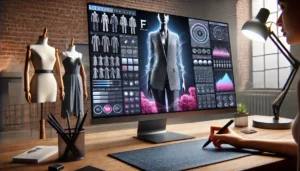The Rise of AI in Fashion Design
The world of fashion has always embraced innovation. Today, one of the most talked-about advancements is “AI fashion design.” It’s more than just a buzzword; it represents a fundamental shift in how we imagine, create, and even experience clothing. What does this mean for fashion designers and consumers alike?
AI in Fashion: Revolutionizing the Industry
The impact of AI on fashion design goes beyond flashy headlines. It’s transforming the industry, streamlining processes, and opening up exciting possibilities. AI empowers fashion brands and designers with tools that were previously unimaginable, allowing them to work smarter, faster, and more creatively.
Also Read: Top 10 AI Tools for Fashion Design in 2024: From Sketching to Production
Trend Forecasting and Data Analytics: AI’s Predictive Power
- AI analyzes massive data sets, including social media trends, sales figures, search engine queries, and even weather patterns, to predict upcoming trends.
- This data-driven approach ensures aligned collections and minimizes losses caused by trend misinterpretations.
- Designers can now focus more on creativity while reducing time spent on tedious tasks.
Streamlining Design Processes: Saving Time, Boosting Creativity
- AI-powered design tools generate multiple design variations based on input or create completely new designs from scratch.
- Automating processes like pattern making and grading ensures better fits for diverse body types and reduces production time.
- Smaller brands and independent designers gain access to tools that were once only available to larger players.
Virtual Try-Ons and Personalized Shopping: Redefining Customer Experience
- AI-powered virtual fitting rooms, like those developed by Bodify and Google, address fit uncertainty in online shopping.
- Personalized styling recommendations based on body type, preferences, and past purchases create a more enjoyable experience.
- This technology promotes sustainability by reducing returns and decreasing the industry’s environmental footprint.
Real-World Examples: AI Design on the Runway
- Brands like Bach Mai and Monse have used AI to create intricate prints featured in their collections.
- Small businesses and individual designers use AI to experiment with custom pieces, patterns, and even futuristic designs.
- Beyond clothing, AI is revolutionizing accessory, footwear, and jewelry design.
The Future of Fashion: Embracing the AI Revolution
- AI will not replace designers but serve as a powerful tool to enhance creativity.
- Successful designers will combine emotional intelligence with AI’s capabilities to create fashion that is both innovative and deeply connected to consumer preferences.
- Collaboration between AI and human creativity will redefine the future of fashion, leading to innovative and personalized designs.
Also Read: 3D Fashion Design and AI: The Tech Transforming Fashion
Conclusion
AI’s entrance into fashion is revolutionary, changing how garments are conceived, designed, and worn. While concerns about job displacement exist, AI is more of a collaborator than a replacement. It empowers designers to innovate, creating fashion that’s both technologically advanced and emotionally resonant.
As AI continues to evolve, its applications in fashion will only grow, making it an indispensable tool for staying ahead in an ever-competitive market.
Also Read: Roblox and Shopify: The Future of Fashion and E-commerce



